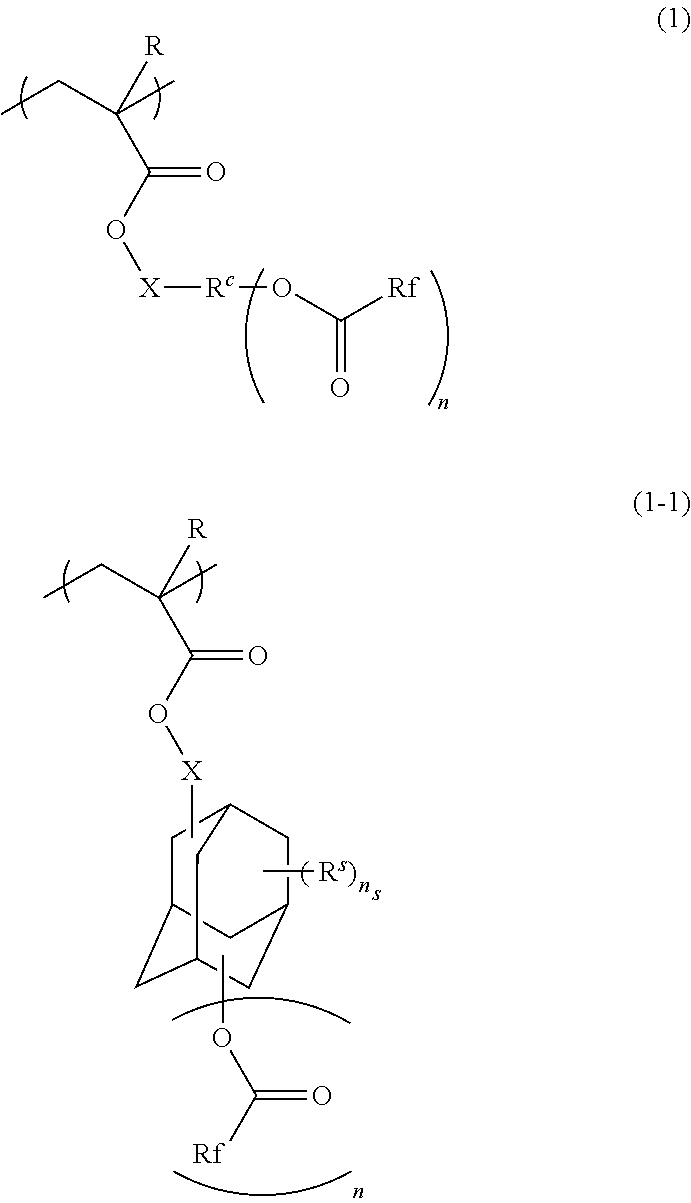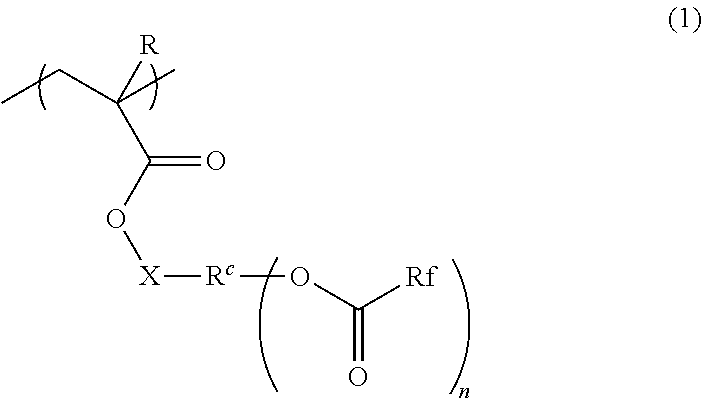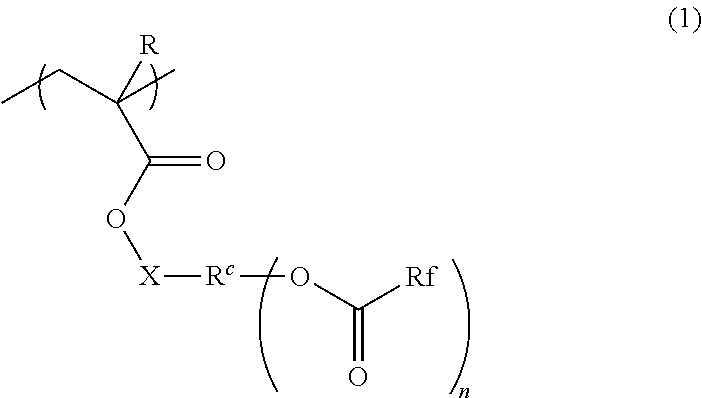Radiation-sensitive resin composition, method for forming resist pattern, polymer and compound
a technology of radiation-sensitive resin and composition, which is applied in the direction of photosensitive materials, instruments, photomechanical equipment, etc., can solve the problems of loss of formability of a pattern, failure to expose at a predetermined refractive index, and more likely to occur bubble defects
- Summary
- Abstract
- Description
- Claims
- Application Information
AI Technical Summary
Benefits of technology
Problems solved by technology
Method used
Image
Examples
example 1
Synthesis of 3-(2,2,2-trifluoroacetoxy)-1-adamantyl methacrylate
[0272]After a reaction vessel which had been sufficiently dried inside by vacuum heating was replaced with dry nitrogen, 23.63 g (0.1 mol) of 3-hydroxyadamantyl methacrylate, 23.10 g (0.11 mol) of trifluoroacetic anhydride and 500 mL of THF were added into the reaction vessel. Thereafter, the mixture was stirred at room temperature for 2 hrs. Subsequently, 300 g of a saturated aqueous sodium bicarbonate solution and 500 mL of ethyl acetate were added thereto, and then the organic layer was separated to obtain an extraction liquid. This extraction liquid was washed with a saturated saline solution, and thereafter dried by adding anhydrous sodium sulfate (drying agent). Thereafter, the drying agent was filtered off with a Buechner funnel, and then the organic solvent was distilled off and the residue was purified on silica gel column chromatography. Accordingly, 3-(2,2,2-trifluoroacetoxy)adamantyl methacrylate (30.95 g (y...
example 2
Synthesis of 3-(methacryloyloxy)-1-adamantyl-2,2,3,3,4,4,4-heptafluorobutanoate
[0275]After a reaction vessel which had been sufficiently dried inside by vacuum heating was replaced with dry nitrogen, 23.63 g (0.1 mol) of 3-hydroxyadamantyl methacrylate, 45.11 g (0.11 mol) of heptafluorobutyric anhydride and 500 mL of THF were added into the reaction vessel. Thereafter, the mixture was stirred at room temperature for 2 hrs. Subsequently, 300 g of a saturated aqueous sodium bicarbonate solution and 500 mL of ethyl acetate were added thereto, and then the organic layer was separated to obtain an extraction liquid. This extraction liquid was washed with a saturated saline solution, and thereafter dried using anhydrous sodium sulfate (drying agent). Thereafter, the drying agent was filtered off with a Buechner funnel, and then the organic solvent was distilled off and the residue was purified on silica gel column chromatography. Accordingly, (methacryloyloxy)-1-adamantyl-2,2,3,3,4,4,4-he...
example 3
Synthesis of (1-(2,2,2-trifluoroacetoxy)adamantyl)methyl methacrylate
[0278]After a reaction vessel which had been sufficiently dried inside by vacuum heating was replaced with dry nitrogen, 25.03 g (0.1 mol) of 1-hydroxyadamantylmethyl methacrylate, 23.10 g (0.11 mol) of trifluoroacetic anhydride and 500 mL of THF were added into the reaction vessel. Thereafter, the mixture was stirred at room temperature for 2 hrs. Subsequently, 300 g of a saturated aqueous sodium bicarbonate solution and 500 mL of ethyl acetate were added thereto, and then the organic layer was separated to obtain an extraction liquid. This extraction liquid was washed with a saturated saline solution, and thereafter dried using anhydrous sodium sulfate (drying agent). Thereafter, the drying agent was filtered off with a Buechner funnel, and then the organic solvent was distilled off and the residue was purified on silica gel column chromatography. Accordingly, (1-(2,2,2-trifluoroacetoxy)-1-adamantyl)methyl methac...
PUM
| Property | Measurement | Unit |
|---|---|---|
| Sensitivity | aaaaa | aaaaa |
Abstract
Description
Claims
Application Information
 Login to View More
Login to View More - R&D
- Intellectual Property
- Life Sciences
- Materials
- Tech Scout
- Unparalleled Data Quality
- Higher Quality Content
- 60% Fewer Hallucinations
Browse by: Latest US Patents, China's latest patents, Technical Efficacy Thesaurus, Application Domain, Technology Topic, Popular Technical Reports.
© 2025 PatSnap. All rights reserved.Legal|Privacy policy|Modern Slavery Act Transparency Statement|Sitemap|About US| Contact US: help@patsnap.com



